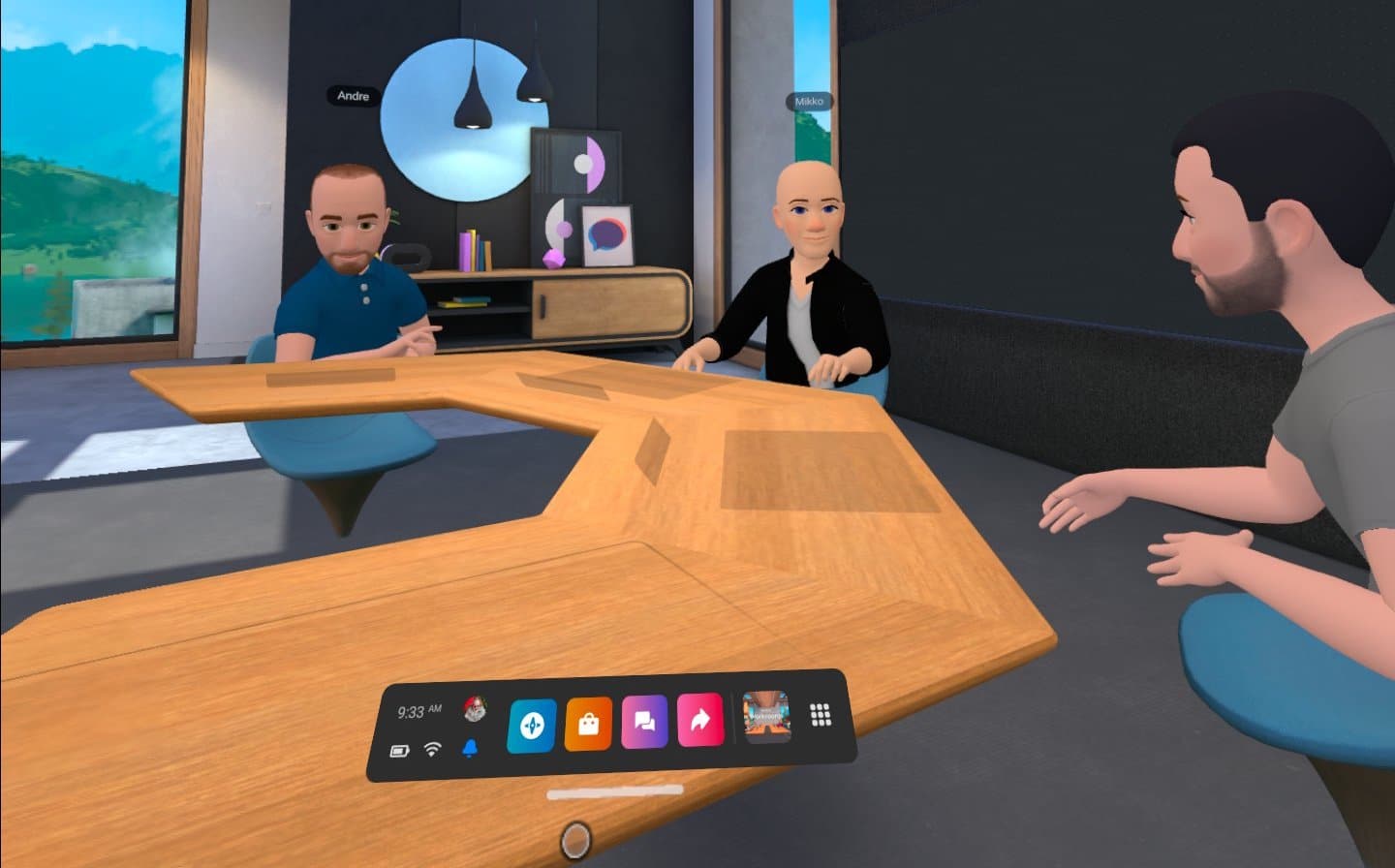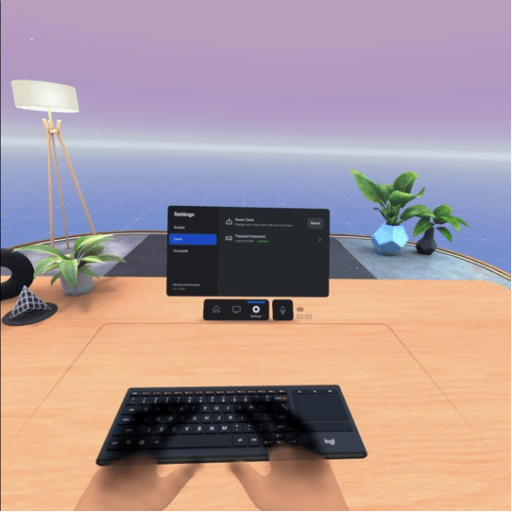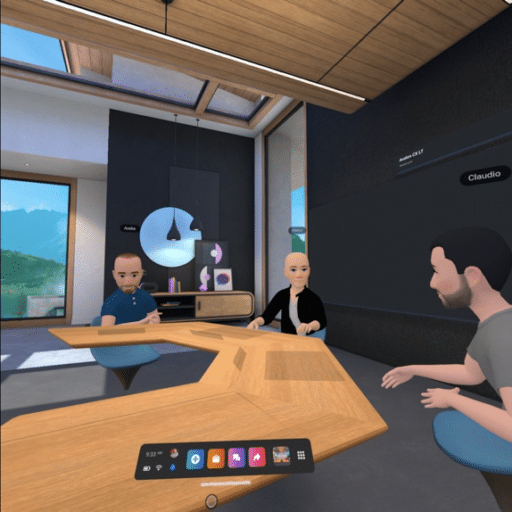Is VR for Business Ready for Prime Time?

Virtual Reality still sounds futuristic even though it has been around for decades. From today’s VR gaming to research to industrial applications, it has been part of any serious technology forecast – and a lot of sci-fi movies as well.
But what about a more colloquial use of VR as a tool to boost collaboration and productivity in a business environment? COVID and remote work definitely brought opportunities in this space, but is VR ready for the everyday business challenge? Avalon CX is looking to find out, and we have started by using Meta Quest VR as a tool for our Management Team meetings. Read about our first impressions below, but let’s first go through a bit of VR background.
A VR Evolution
“Wow! This is going to change the world!” – those were my first thoughts after experiencing VR for the first time – as a student volunteer at ACM Siggraph Conference in Los Angeles in 1995.
I was hooked up to these cumbersome, heavy headsets tethered to some seriously powerful (by those days’ standards) SGI servers. I was given one remote control with a button that represented my “hand” in the VR space. I could then grab and manipulate some simple boxes and even see another participant’s crude avatar in front of me.
Twenty-six years later, a lot of advancements have been made – from the obvious evolution of computing power, higher-resolution screens, and refresh rates to less cumbersome and untethered headsets. But as with most new technology, adoption depends on several factors, sometimes unforeseen by the companies bringing the tech to market.
“COVID pandemic lockdowns brought a new challenge for companies with remote employees: How do we improve team interactions?”
One of the things I have learned as a tech/geek is that not everyone is a tech/geek. And that has changed my perception of what constitutes a viable product – why would any person be interested in such tech, and what problem does it solve?
As an example, 3D TVs were all the rage more than a decade ago. By that time, all major brands were jumping on the bandwagon and making their best effort to prove that home 3D would be the big thing. And it was! For those who were watching it. And the ones who were watching needed 3D glasses – Some were battery-powered and required charging – but watching a TV is a social event. It’s more about being around family and friends and less about you watching that great content in weird 3D on a rather small TV. It missed the Customer Experience part.
So, how about VR? Virtual reality has been in the media for as long as I can remember. Lawnmower Man, a movie from 1992, depicts a gruesome future where we are not in control of our lives anymore. Since then, the subject of VR has been depicted in the mainstream media abundantly, with the latest high-grossing film being “Ready Player One” – which depicts a more believable future.
Recently, gaming has been the driving force in the VR space. Sony, and other manufacturers, have been pushing it on their consoles because gamers are playing online more than in person, which makes it a compelling proposition. The same can be said about HTC Vive and the Oculus rift series. Both are taking advantage of online gaming to prove that VR is a viable and compelling product via Steam online.
“Recent advancements in technology (together with more reasonable pricing) are making it possible to start considering VR as an alternative to video calls.”
Other more specific uses of VR/AR are in industrial/engineering/medical settings where there are already environmental and spatial contexts to create unique user experiences, from teaching anatomy on a 3D body to students to accessing CAD designs of airplane parts.
VR, AR, XR…
Although there are a lot of gray areas, let’s start by briefly defining some of the (sometimes confusing) terms and what they mean:
- VR stands for “Virtual Reality”, and it is an all-encompassing term to define a technology that allows you to be fully immersed in a computer-simulated environment. This is generally achieved through a headset with dual displays (one for each eye) that uses some type of motion tracking (cameras, accelerometers, infrared sensors, gyroscopes) to translate real head movements into the 3D-generated content you are seeing through the lenses.
- AR (augmented reality), MR (mixed reality), and XR (extended reality) are more or less a variation of VR where 3D or other content is superimposed with your real view. It works for some applications, like when you use your phone’s camera to see how that sofa would look in your living room or when you have street directions laid out for you on a Google-glass type of device. It’s another ball game for next-level AR applications to really make sense of one’s surroundings and dynamically layover more complex 3D content that interacts with real-life objects.
How about VR for business?
COVID pandemic lockdowns brought a challenge for companies where people are working remotely: how to improve team interactions?
Yes, videoconferences serve a purpose, but they still lack a lot of what makes presential meetings more productive – from looking directly at who is talking and the audience to observing subtle expressions that cannot be grasped on video – not to mention the decreased audience engagement from video conferences. For a lot of people (myself included), it’s a lot easier to concentrate if fully immersed in the same room as a presenter or speaker is giving his/her ideas or discussing a subject.
Recent advancements in technology (together with more reasonable pricing) are making it possible to start considering VR as an alternative to video calls. Until recently, most VR headsets relied on two restrictive aspects: they had to be tethered (connected to a sufficiently powerful laptop/desktop via a cable) AND required external emitters used for real-time head tracking. Today you can find untethered hardware solutions (e.g. FB/Meta Quest VR) that rely on a set of properly positioned cameras on the headset itself to make sense of the surroundings and head movement. That opened the doors to a new potential market: People working remotely.
New VR applications are being released to tackle the challenge, and most start from the meeting room. Some of the basic features you would expect are the ability to see and interact virtually in 3D with your work colleagues in the same virtual meeting room, as well as:
- Hear who is talking and from which direction (spatial audio) clearly
- Have some form of representation of you and see the representation of your colleagues (some are cartoonish, some more life-like) that show a level of expressions
- Be able to share documents, videos, photos, spreadsheets, etc in a way that is both visible and compelling
- Accommodate others that join without VR – see and interact with a video participant.
- Whiteboarding: one of the key elements in any meeting, a proper feature that allows many people to collaborate on the same virtual enhanced whiteboard.
And how are these new solutions working out? Are they really a breakthrough for collaboration and interaction? Will they leverage the way we feel connected with work colleagues and be more productive? Avalon CX is on a mission to find out. As forerunners of tech, we have been early adopters of VR for business and are now weighing the pros and cons of using VR in some of our meetings. We have started replacing the daily management meeting video calls with Horizon Workrooms VR sessions using FB/Meta’s Quest 2 devices. Here is a rundown of our first impressions:
Setup
Since the device is self-contained (it does not need a computer to operate), the overall setup is simple: once you create an account, you just need to download the WorkRooms VR app (and have it configured and connected to your business email/calendar accounts online). To be able to see and share your computer screen and documents during the VR meeting, you also need to install an Oculus remote desktop app on the computer that will allow it to communicate with the device.
Overall Use
Once set up, Workrooms allow you to create and send invitations to VR meetings. Before entering a VR meeting room, you will be walked through how to define your desk in VR (that replicates the same size and position of your real desk) as well as a work area where you can “see-through” what is in your real desk – so you can sip that real coffee even while in VR.
You will also be able to customize your avatar to your liking, from hairstyle to clothes.
Another great feature is the ability to map and track your keyboard (limited to some models as of now), so you can type and see the real position of your keyboard while immersed in VR.

We found out that the device is light and comfortable enough to be worn for our 30 min meetings with no eye fatigue or VR dizziness.
Meeting Room Experience
Once you join a VR meeting on WorkRooms, you are inside a modern, well-lit, and decorated meeting room with windows to beautiful mountain scenery. You will be able to see other participants’ avatars “sitting” around the table (no legs!) and hear their voices from the same direction where they are sitting. This is a major step up from video calls where it’s not possible to have the spatial audio experience. You can set up as many different meeting rooms as you want and for any purpose, like having a dedicated room for strategy sessions, one for all hands, and another for happy hours (virtual beer, anyone?)
The headset tracks the hand and finger movements quite accurately and simulates expressions and mouth movements based on audio measurements, and does the job well.

The meeting table size is dynamically adjusted depending on the number of participants, but you can also change its layout – from a round table to an auditorium-style format. Changing your seat is also possible during the meetings – and the spatial audio is dynamically adjusted to change the position from where your voice is coming from – simply magical.
In front of you, there is a desk space where you can see your keyboard and options for opening a virtual monitor in front of you that shows your computer screen – as if you were using it in the real world.
One of the most interesting features is the virtual whiteboard. You can define space on a wall in your real-life room that will represent the whiteboard in VR. You then can “walk” from your seat and draw on the whiteboard using the VR remote as a marker. It works great, and you are not only able to change colors and add content from your PC (like images) but also roll the board to the sides to have more space too. Moreover, the whiteboard retains its content through sessions, so there are no more sticker notes with “please do not erase” messages.
Also, you can choose to draw on your desk space wising the same tools, and the result is then “projected” to the main whiteboard in the room for all to see and collaborate.
You can invite non-VR participants to the meeting as well. Their video will show up on a floating display by the edge of the meeting table. They can share content in full screen to all participants as well – that can be seen in front of each participant’s “virtual monitor”
Our impressions so far
We found VR meetings to be a surprisingly pleasant experience. Even cartoonish avatars somehow convey a better sense of reality than an ordinary video call. The conversations seem more fluid and natural, and sharing ideas through sketching and documents was a breeze.
VR is so convincing that sometimes you may find yourself trying to put your feet on the empty seat beside you. Another positive thing is how much you are blocked from distractions while immersed in VR: you won’t end up checking every notification on your phone or every email you receive while you are focused on a VR session.
Of course, there are some getting used to, like remembering to charge your headsets, making sure the desktop sharing is enabled, etc., and time will tell if this compromises adoption. Also, since Workrooms is still in Beta, some kinks still need to be ironed out – we had a couple of cases where the room froze, or we had to reboot the headset. We should also expect new features as more people start using them.
We are now expanding from the pilot to every Avalon CX employee – and we will find out other situations where it can be useful and increase collaboration and productivity) and where/when it doesn’t make sense to use VR)
Read more about our follow-up post with details on how the whole experience is taking place.
More info on Workrooms at Meta Introducing ‘Horizon Workrooms’.

